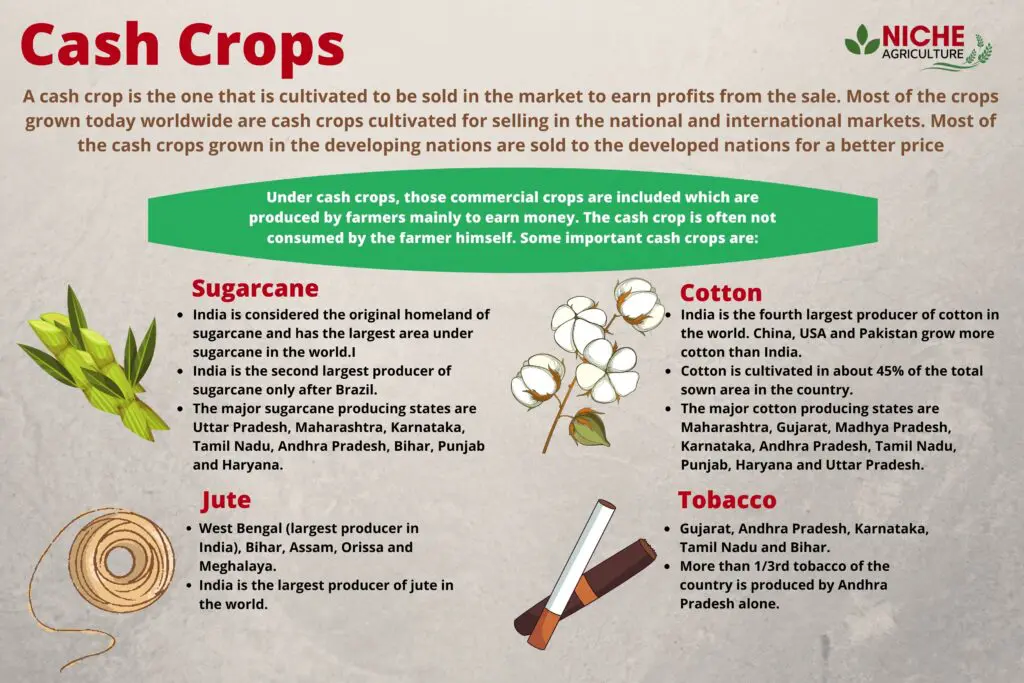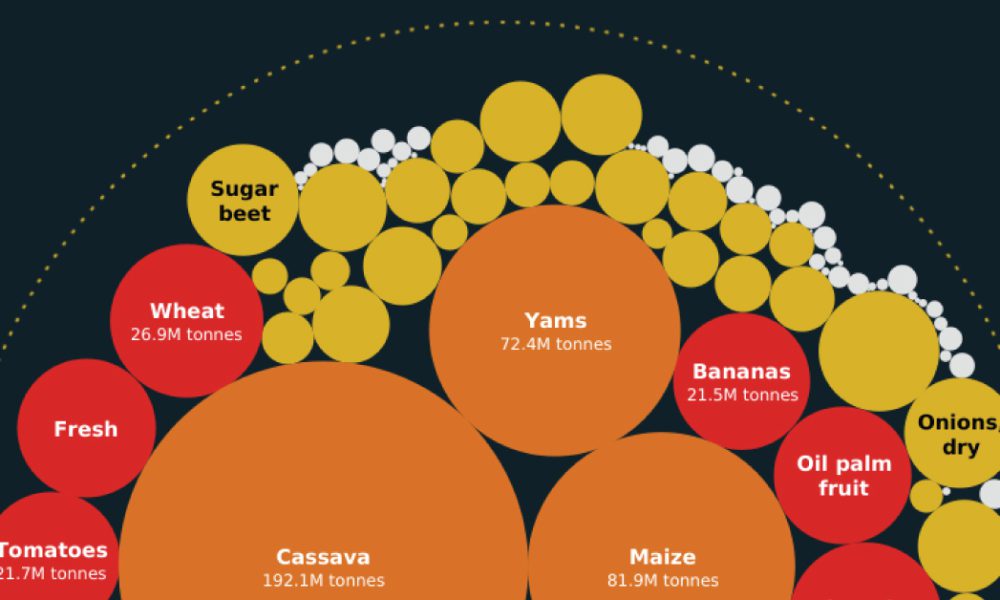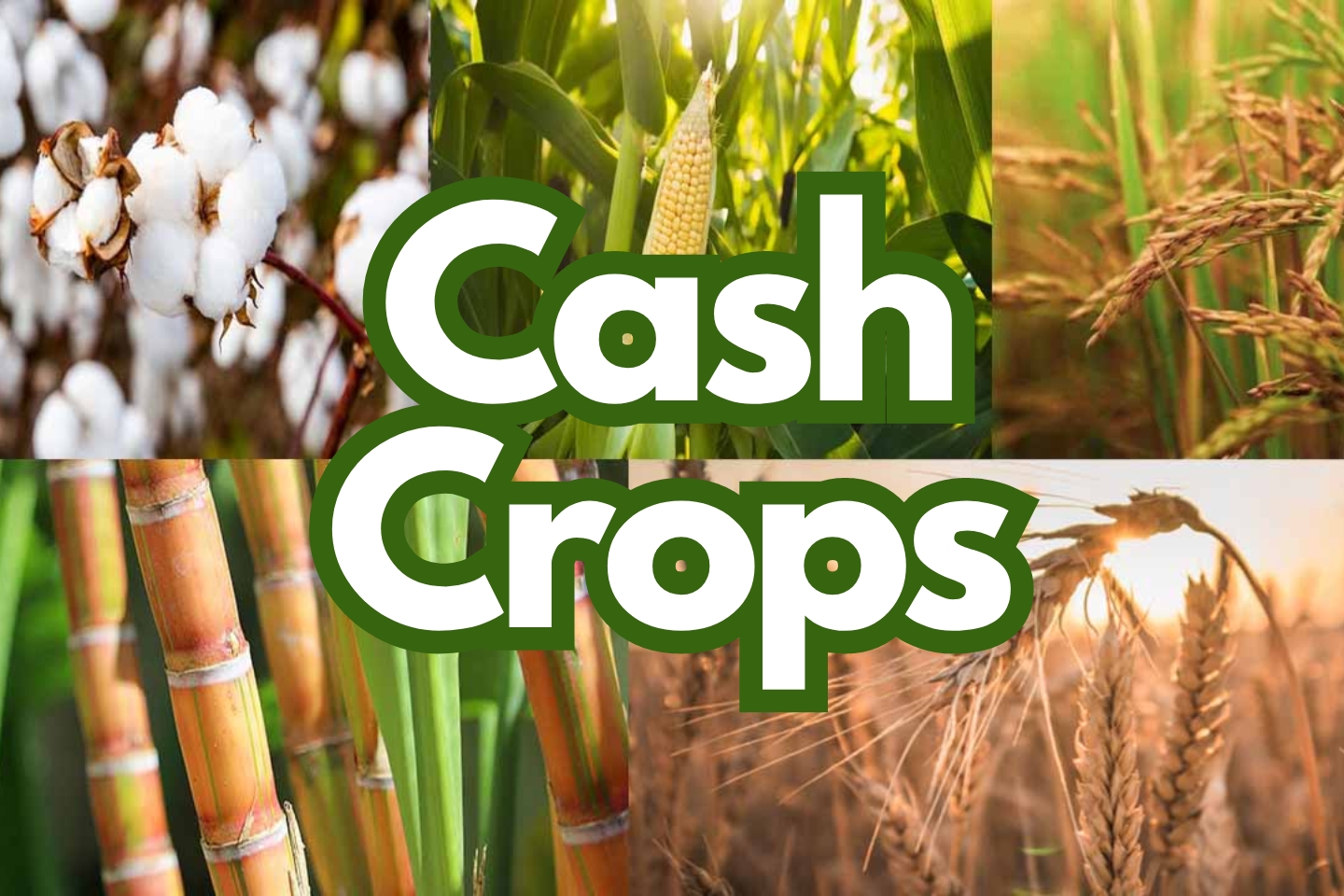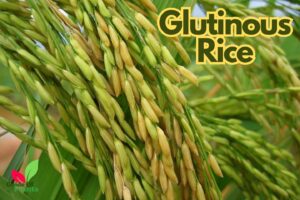Cash crops are agricultural crops that are grown to be sold for profit. This crops are usually sold in the global markets. It is not consumed like other regular crops by the farmers who cultivate them. Cash crops are typically exported to other countries. It generate income for farmers or manufacturers and also export economies. Cash crop farming has a long history tied to colonialism and global trade.
Table of Contents
What are Cash crops?
Cash crops are agricultural crops that are grown specifically for commercial profit rather than for subsistence. They are typically exported to other countries. This crops are provide income for farmers. The major Cash crops globally include coffee, tea, cotton, tobacco, sugarcane, cocoa, rubber, bananas, soybeans, and timber.

Regional crops that are important for export income include olives, nuts, spices, hemp, grapes, vegetables, and many more locale-specific crops. This crops are distinguished from subsistence crops in that they are grown not mainly to feed local populations but rather as commodities to be sold in domestic or international markets. Key crops have come to dominate agricultural production and trade worldwide.
Know About: Soybean Plants
The History and Origins of Cash crops
Cash crop farming has a long history tied to global trade and colonialism. Some early crops grown for export starting in the colonial period include tobacco, cotton, sugar, and indigo. Growing these crops allowed colonists in the Americas and elsewhere to export valuable commodities back to Europe, participating in the emerging global economy.

Cash crop farming greatly expanded worldwide throughout the 19th and 20th centuries as international trade grew and farmers specialized in the most profitable crops. Cash crops were also essential to many colonial economies. It provides income for settlers through export but also reinforcing economic dependence on Europe. After colonization ended, crops continued to drive export economies in many developing countries.
The cultivation of this crops for trade persists today. It links farmers globally to international markets. It also helps to shape patterns of agricultural production worldwide.
Major Cash crops Grown Today
- Wheat – One of the most widely cultivated cereal crops and an important food staple. Most wheat producers are manufactured in China, India, Russia, United States, France and Germany.
- Corn – A versatile cereal crop used for food, animal feed, ethanol fuel and more. Top producers are the United States, China, Brazil, Argentina and Ukraine.
- Rice – A staple food crop for over half the world’s population. Leading producers are China, India, Indonesia, Bangladesh and Vietnam.
- Soybeans – A legume crop used for vegetable oil and animal feed. The United States, Brazil, Argentina, China and India are top global producers.
- Coffee – An economically important commercial crop grown in tropical regions. Brazil, Vietnam, Colombia, Indonesia and Ethiopia lead production.
- Cocoa – The source of cocoa butter and chocolate. Top producers are Ivory Coast, Ghana, Indonesia, Nigeria and Cameroon.
- Rubber – Derived from the latex of the rubber tree. Key producers are Thailand, Indonesia, Vietnam, China and Malaysia.
- Cotton – A top source of textile fiber. Major producers include India, China, United States, Pakistan and Brazil.
- Tobacco – Grown for its leaves which are cured for smoking and chewing. China, Brazil, India and the United States are major producers.
- Sugarcane – Cultivated for sugar and biofuels. Brazil, India, China, Thailand and Pakistan lead production.
- Tea – Derived from tea plant leaves. Main producers are China, India, Kenya, Sri Lanka and Turkey.

Why Farmers Grow Cash crops
Cash crops offer farmers the potential for higher income compared to growing subsistence crops. As global trade expanded, many farmers transitioned to cultivating the most profitable crops in order to earn money to purchase goods, pay taxes, and improve their livelihoods. Cash crop farming allowed agricultural producers to shift away from subsistence farming.
Higher Income Potential
The primary reason farmers grow this crops is their higher income earning potential compared to traditional subsistence crops. This crops can generate significantly more money per acre when sold into commercial markets. This provides cash income for farmers to use beyond basic food and living expenses. As global trade increased access to markets, cash crop farming became economically appealing.
Respond to Market Demand
Farmers also grow specific crops to respond to global market demand. By specializing in commodities that are in continual demand worldwide, like coffee or cotton, farmers can maintain profitable markets for their harvests. This market-driven production focuses on the most valued crops.
Shift Away from Subsistence Farming
Cash crop farming marks a transition away from subsistence agriculture in which farmers grow mainly for their household needs. Cash crops allow farmers to earn income through farming. It helps to purchase goods, pay taxes, and buy inputs to improve crop yields. This shift toward commercial farming began during colonial times.
Cash Crop Monocultures
The focus on growing profitable crops has led some farmers to plant monocultures of a single cash crop. But monoculture crops are more vulnerable to pests, drought, and price fluctuations. Many advocates now encourage more sustainable polyculture methods.
The Economics of Cash crops
Cash crops represent an important economic sector, subject to global market forces of supply and demand. Prices and markets for key commodities impact farmer livelihoods and international trade. Governments often subsidize this crops.

Supply and Demand Dynamics
Like other commodities, prices and production volumes of Cash crops are influenced by basic supply and demand. Weather shocks, planted acreage, and crop yields affect global supply. Rising incomes and populations impact demand. This shapes the market fundamentals driving cash crop economics.
Commodity Prices and Volatility
Cash crop commodity prices tend to be volatile, fluctuating year-to-year with supply and demand shifts. Price spikes and crashes present risks for farmers relying on cash crop revenue. Many cash crop prices also exhibit long-term declines due to rising productivity.
Government Subsidies and Support
Governments often provide subsidies, price controls, or other support to incentivize domestic cash crop production and protect farmer income from volatility. However, subsidies can distort global commodity prices when applied to traded this crops.
Impact on Farmer Income and Risk
Cash crop income allows many farmers to significantly improve their livelihoods. But reliance on this crops also exposes farmers to financial risks from price changes. Cash crop monocultures are also more environmentally vulnerable than diverse subsistence farming.
Know About: Brassica Rapa
The Good and Bad of Cash crops
Cash crops provide major economic benefits but also risks if pursued unsustainably. Environmentally conscious cash crop farming integrated with regional food production can balance these tradeoffs. Diversification into multiple crops reduces farmer exposure to price volatility. Overall, cash crop play a complex role in agriculture and development.
The Good
- Cash crops can significantly boost farmer income compared to subsistence agriculture. This allows investment in equipment, inputs, and technology.
- Cash crop generate major export earnings for many developing economies. This provides income to finance development.
- Transitioning to cash crop encourages participation in global trade. It links farmers to international markets.
The Bad
- Reliance on a few cash crops risks overspecialization. This makes farmers vulnerable to commodity price swings.
- Cash crop monocultures reduce crop diversity, lowering nutritional security. Less land goes to subsistence foods.
- Cash crop farming is often more chemical and water intensive. This can degrade soils, waterways, and ecosystems over time.
- Local food security declines if most farmland goes to exported cash crops rather than domestic food production.
Know About: Bamboo Rice
Sustainable Cash Crop Farming
With the rise of large-scale industrial cash crop agriculture, sustainability has become an increasing concern. However, there are various practices that can make cash crop farming more environmentally sound and socially ethical.
Organic and eco-friendly farming techniques help make cash crop cultivation more sustainable. These include using natural fertilizers and pest control methods, avoiding chemical inputs, and employing water conservation irrigation strategies. Transitioning to renewable energy sources also reduces the carbon footprint of cash crop production.
- Crop rotation, cover cropping, and other soil health practices can counter degradation from intensive cash crop farming. This maintains land quality over repeated harvests.
- Conservation efforts like preserved wildlife habitat, riparian buffers, and tree lines prevent erosion and ecosystem damage in cash crop farming areas. Regulations can also enforce sustainable land use policies.

Sourcing this crops through fair trade organizations provides social sustainability benefits. This ensures fair labor standards and a greater portion of profits going back to small-scale farmers in developing nations. Ethical sourcing helps this crops spread their economic advantages more equitably.
For example, many coffee companies now offer fair trade certified coffee at the premium end of their product range. This supports fair wages and sustainable practices among coffee growers.
Overall, integrating sustainable techniques allows cash crop farming to balance productivity with environmental and social responsibility. The right policies and market incentives can encourage widespread adoption of these methods.
The Future of Cash Crops
Advanced agronomic practices and technology will shape the future of cash crops. While also responding to the challenges of climate change and shifting global consumption patterns. Key influences going forward will be developing heartier and higher-yield GM and hybrid cash crops along with more sustainable farming methods and water-efficient irrigation to maintain robust yields.
Cash crop agriculture will also need to adapt to the impacts of climate change in vulnerable regions and produce alternatives to traditional cash crops that are falling out of favor due to health concerns. Overall, the cash crop sector aims to increase production and profits through innovations in seed technology and agronomy, while also transitioning to environmentally sound and ethical practices to ensure long-term productivity and social benefits.
Know About: Paddy Rice Cultivation

Conclusion
Cash crops are essential to the global agricultural economy. Grown specifically for commercial profit rather than subsistence. Dominanting cash crops today include coffee, soybeans, palm oil, rubber, and cotton. The history of cash crops is intertwined with colonial trade and the expansion of large-scale corporate agriculture. While bringing income benefits, cash crop monocultures carry environmental and social risks if not sustainably managed.
Striking the right balance through eco-friendly practices, crop diversification, and fair labor standards allows cash crop farming to positively contribute to farmer livelihoods and national development while minimizing its drawbacks. Going forward, the cash crop sector will continue responding to market demand, productivity enhancements, and environmental challenges. Overall, cash crops will remain essential commodities linking farmers to consumers worldwide.




